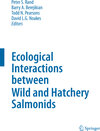
Ecological Interactions between Wild and Hatchery Salmonids
herausgegeben von Peter S Rand, Barry A. Berejikian, Todd N. Pearsons und David L.G. NoakesWhile there has been a long history of salmon hatchery operations throughout the North Pacific, only recently have we begun to investigate how hatchery salmon interact with their wild counterparts. This volume represents our latest understanding of the scale and magnitude of effects of hatcheries on wild salmon populations, and begins to lay the groundwork for precautionary fisheries management to ensure that wild salmon are conserved. Reprinted from Environmental Biology of Fishes volume 94 issue 1
Research on hatchery and wild salmonid interactions is increasing exponentially and this book provides a synthesis of what researchers believe today. Of greatest importance is that it shows how little we know. Mart Gross, University of Toronto, Canada
Wild and hatchery salmon interactions are key to understanding human impacts on the North Pacific ecosystem. This publication represents an important step in understanding both the benefits and the risks.– Vladimir Radchenko, Pacific Scientific Research Fisheries Center, TINRO Center, Russia
Through careful case histories, creative manipulative experiments, and impressive quantitative modeling, scientists and managers have come together to publish this touchstone work, work simply indispensable to our continuing efforts to “bring the salmon back”. – Roy Stein, Ohio State University, USA
This book will become required reading for scientists and managers around the world dedicated to the conservation of wild salmon. – Hideaki Kudo, Hokkaido University, Japan



